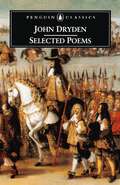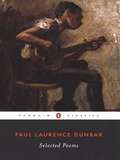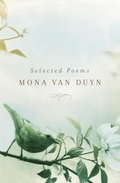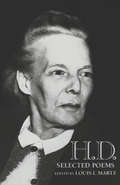- Table View
- List View
Selected Poems: Selected Poems (Dover Thrift Editions: Poetry)
by John DonneConsidered by many critics the foremost English "metaphysical" poet, John Donne (1572–1631) earned renown for both sacred and secular verse, his love poems in the latter genre ranking among his most original and popular works. Brilliant and wide-ranging, Donne's verse is distinguished by its passion, insight, and inspired use of striking metaphors or "conceits." This volume contains a rich selection of the poet's best work, including, from the Songs and Sonnets: "The Good Morrow," "The Canonization," "The Relic," and "A Valediction: Forbidding Mourning"; from the Elegies: "On His Mistress" and "To His Mistress Going to Bed"; a selection from the Holy Sonnets (including "Death Be Not Proud"); "Good Friday. 1613. Riding Westward," "Hymn to God My God, in My Sickness" and many more.
Selected Poems (Dover Thrift Editions: Poetry)
by John DrydenThe leading English literary figure of the latter half of the 17th century, John Dryden (1631-1700) wrote dramas and critical works, but his reputation stands on his mastery of verse, in particular the heroic couplet. Encompassing political, religious, philosophic, and artistic issues, Dryden's poetry offers rich evidence of his social consciousness. "Annus Mirabilis," a celebration of the tumultuous events of 1666, casts the catastrophic effects of war, plague, and London's Great Fire as a providential gesture, from which the nation would arise, phoenix-like, to greater heights. Other selections in this volume include his great satires "Absalom and Achitophel" and "Mac Flecknoe," along with "Song from Marriage à la Mode," "To the Memory of Mr. Oldham," "A Song for St. Cecilia's Day," "Epigram on Milton," and "Alexander's Feast." Dover original selection of poems from standard texts. New Publisher's Note.
Selected Poems
by John DrydenA new and comprehensive selection of Dryden's poetry, revealing him as a master of theatricality, ventriloquism, and unmistakable originality. Brought together here are many of the poems from his time as Poet Laureate and loyal servant of the crown, including the Biblical allegory 'Absalom and Achitophel', in which the poet attacked those who intrigued against the King and earned himself a reputation for menace and a number of powerful enemies. His 'Works of Virgil' set the standard for the translation of Latin poetry. His last work, 'Fables Ancient and Modern' combined original verse and new translations, showing how he transformed the idioms and gestures of other voices and made them his own.
Selected Poems (Dover Thrift Editions: Black History)
by Paul Laurence DunbarDubbed the "Poet Laureate of the Negro race" by Booker T. Washington, Paul Laurence Dunbar (1872-1906) is best known for his lively dialect poems. In addition to his dialect verse, however, Dunbar also wrote fine poems in standard English that captured many elements of the black experience in America.This volume contains a representative cross-section of both types of verse, including "Ode to Ethiopia," "Worn Out," "Not They Who Soar," "When Malindy Sings," "We Wear the Mask," "Little Brown Baby," "Dinah Kneading Dough," "The Haunted Oak," "Black Samson of Brandywine" and many more.A rich amalgam of lyrics encompassing patriotism, a celebration of rural life and homey pleasures, anger at the inequalities accorded his race, and faith in ultimate justice, this collection affords readers an excellent opportunity to enjoy the distinctive voice and poetic technique of one of the most beloved and widely read African-American poets.
Selected Poems
by Paul Laurence Dunbar Herbert MartinPaul Laurence Dunbar was "the most promising young colored man" in nineteenth-century America, according to Frederick Douglass, and subsequently one of the most controversial. His plantation lyrics, written while he was an elevator boy in Ohio, established Dunbar as the premier writer of dialect poetry and garnered him international recognition. More than a vernacular lyricist, Dunbar was also a master of classical poetic forms, who helped demonstrate to post-Civil War America that literary genius did not reside solely in artists of European descent. William Dean Howells called Dunbar's dialect poems "evidence of the essential unity of the human race, which does not think or feel black in one and white in another, but humanly in all."
Selected Poems
by Mona Van DuynThis generous selection of Mona Van Duyn’s distinguished, award-winning work spans four decades. Beginning with her classicValentines to the Wide World(1959), encompassing the intimate voice ofBedtime Stories(1972) and the movingLetters from a Father(1982), crowned by the life-spanningFirefall(1993),Selected Poemsreacquaints us with a poet whose ear is keenly tuned to the music of nature and human conversation. In lively and varied forms, from her minimalist sonnets to her magisterial longer pieces, Van Duyn captures a multiplicity of worlds within her world, in a tone inflected by both Midwestern pragmatism and a deep metaphysical intelligence. As she contemplates the act of reading in bed, a Rhenish sculpture in the Cloisters, or the loss of her mother, the poet goes beyond context to discover consciousness: an expression of the larger ideas and emotions—finally, the art—in the smallest details of our lives. From the Hardcover edition.
Selected Poems
by T. S. EliotChosen by Eliot himself, the poems in this volume represent the poet's most important work before Four Quartets. Included here is some of the most celebrated verse in modern literature--"The Love Song of J. Alfred Prufrock," "Gerontion," "The Waste Land," "The Hollow Men," and "Ash Wednesday"--as well as many other fine selections from Eliot's early work.
Selected Poems (Dover Thrift Editions)
by Thomas HardyWidely known as the author of such classic novels as The Return of the Native and Tess of the D'Urbervilles, Thomas Hardy (1840-1928) was also a great poet. His lyricism, subtlety, depth, and variety have earned him a significant place in the ranks of modern English poets.This modestly priced volume contains seventy of Hardy's finest poems, including "The Darkling Thrush," "Hap," "The Ruined Maid," "The Convergence of the Twain," "I Look Into My Glass," "Ah, Are You Digging on My Grave?" and many others. These remarkable poems offer ample evidence of Hardy's intense perception and his peculiar power to express deep emotion. They also reflect his distinctive style, which fuses a reliance on traditional stanza formats and rhyme with a unique diction and imaginative power.
Selected Poems
by Thomas HardyA generous selection of poems by a major Victorian writer, a virtuoso of traditional forms who came to be recognized as a uniquely inventive and original voice in modern poetry This selection of poems by Thomas Hardy (1840–1928), edited by David Bromwich, covers the range of Hardy’s extraordinary work: songs, ballads, and sonnets, dramatic monologues and elegies, along with poems that mark epochal events, such as the end of the Great War. This selection shows why Hardy has been admired as the most inward and personal of the moderns, yet also the most accessible and widely read. Included here is the full and integral text of Chosen Poems of Thomas Hardy, the final selection of his own work that Hardy chose to publish. Bromwich has selected more than one hundred fifty additional poems that cover the length of Hardy’s career, from Wessex Poems to Winter Words. His critical and biographical introduction sets Hardy’s achievement in the context of a career in prose and poetry that has no parallel.
Selected Poems
by Tony HarrisonA revised edition of Tony Harrison's award-winning Selected Poems This indispensable new selection of Tony Harrison's poems includes over sixty poems from his famous sonnet sequence The School of Eloquence and the remarkable long poem 'v.', a meditation in a vandalized Leeds graveyard which caused enormous controversy when it was broadcast on Channel 4 in 1987 and is now regarded as one of the key poems of the late twentieth century.This substantially revised and updated edition now also features a generous selection of Harrison's most recent work, including the acclaimed poems he wrote for the Guardian on the Gulf War and then from the front line in the Bosnian War which won him the Wilfred Owen Award for Poetry in 2007.Selected Poems is a collection to be savoured by fans of Carol Ann Duffy, Seamus Heaney, Simon Armitage and Sophie Hannah.'A voracious appetite for language. Brilliant, passionate, outrageous, abrasive, but also, as in the family sonnets, immeasurably tender' Harold Pinter'In the front rank of contemporary British poets. Harrison's range is exhilarating, his clarity and technical mastery a sharp pleasure' Melvyn Bragg'The poem "v." is the most outstanding social poem of the last twenty-five years. Seldom has a British poem of such personal intensity had such universal range' Martin Booth'Poems written in a style which I feel I have all my life been waiting for' Stephen Spender'A poet of great technical accomplishment whose work insists that it is speech rather than page-bound silence' Sean O'Brien, The Oxford Companion to Twentieth-Century Poetry
Selected Poems
by Anthony HechtAlongside Wallace Stevens, James Merrill, and other pillars of twentieth-century poetry, Anthony Hecht joins the Borzoi Poetry series.Hecht, whose writing rings with the cadences of the King James Bible, and who, as an infantryman at the end of World War II, participated in the liberation of the concentration camps, lived and experienced the best and worst of the twentieth century. Readers of this volume--the first selected poems to be made from Hecht's seven individual volumes--will be captivated by Hecht's dark music and allusions to the literature of the past. As J. D. McClatchy explains in his introduction, Hecht was a poet for whom formal elegance was inextricably bound up with the dramatic force, thematic ambition, and powerful emotions in each poem. The rules of his art, which he both honored and transformed, are "moral principles meant finally to reveal the structure of human dilemmas and sympathies."This elevated sense of what poetry can accomplish defines our experience of reading Hecht, and will ensure his place in the canon for years to come.Adam and Eve knew such perfection once,God's finger in the cloud, and on the groundNothing but springtime, nothing else at all.But in our fallen state where the blood huntsFor blood, and rises at the hunting sound,What do we know of lasting since the fall?Who has not, in the oil and heat of youth,Thought of the flourishing of the almond tree,The grasshopper, and the failing of desire,And thought his tongue might pierce the secrecyOf the six-pointed starlight, and might choirA secret-voweled, unutterable truth?--from "A Poem for Julia"From the Trade Paperback edition.
Selected Poems
by Richard Hugo<P> The poems in this volume were selected by the poet in 1978 from his first three books—A Run of Jacks, Death of the Kapowsin Tavern, and Good Luck in Cracked Italian—and from his three more recent books, The Lady in Kicking Horse Reservoir, What Thou Lovest Well Remains American, and 31 Letters and 13 Dreams. <P> The result easily demonstrated, then as now, the massive achievement of the writer whom Carolyn Kizer called "one of the most passionate, energetic, and honest poets living."
Selected Poems: Selected Poetry In French And English (Fyfield Books)
by Victor HugoThis generous, varied selection of poems by one of France's best-loved and most reviled poets is presented with facing originals, detailed notes, and a lively introduction to the author's life and work. Steven Monte presents more than eighty poems in translation and in the original French, taken from the earliest poetic publications of the 1820's, through collections published during exile, to works published in the years following Hugo's death in 1883. The introduction provides helpful background information about Hugo's life and work, the selection, and what is involved in translating a poet whose effortless rhymes are central to the poetry's power. Detailed notes at the back of the volume offer information about the poems and their publishing and historical contexts. This is an ideal introduction to a poet whose work, for all its renown, remains for Anglophone readers undiscovered.
Selected Poems
by Victor Hugo Brooks HaxtonFor most of his life, Victor Hugo (1802-1885) was the most famous writer in the world. His legacy includes the nineteenth century's most celebrated works of drama, fiction, memoir, and criticism. But in his day Hugo was know foremost as a poet-indeed the greatest French poet of the age. He wrote with passion about history, erotic experience, familial love, philosophy, nature, social justice, art, and mysticism. In this new bicentennial edition, acclaimed poet and translator Brooks Haxton offers an exquisite selection of Hugo's finest work: love poems, historical tableaux, elegy, and idyll, including his incomparable "Boaz Asleep," which Marcel Proust praised as the most beautiful poem of the nineteenth century.
Selected Poems
by Robinson JeffersThe poems in this volume have been selected from Robinson Jeffers' major works, among them Be Angry at the Sun, Hungerfield, The Double Axe, The Beginning and the End, and Roan Stallion, and Tamar and Other Poems.
Selected Poems (Penguin Modern Classics)
by Patrick KavanaghPublished in order of first publication as far as possible, this selection ranges from initial offerings such as 'Tinker's Wife' and 'Inniskeen Road: July Evening' to his tragic masterpiece 'The Great Hunger' (1942) and his celebratory later verse, 'To Hell with Common Sense' and 'Come Dance with Kitty Stobling', which show his increasing comic verve and detachment. The first comprehensive selection of Kavanagh's poetry to be published, this volume offers a timely reassessment of a poet unfairly neglected outside Ireland.
Selected Poems: Selected Poems (Macmillan Collector's Library #188)
by John KeatsOver the course of his short life, John Keats (1795-1821) honed a raw talent into a brilliant poetic maturity. By the end of his brief career, he had written poems of such beauty, imagination and generosity of spirit, that he had - unwittingly - fulfilled his wish that he should ‘be among the English poets after my death’. This wide-ranging selection of Keats’s poetry contains youthful verse, such as his earliest known poem ‘Imitation of Spenser’; poems from his celebrated collection of 1820 - including ‘Lamia’, ‘Isabella’, ‘The Eve of St Agnes’, ‘Ode to a Nightingale’ and ‘Hyperion’ - and later celebrated works such as ‘La Belle Dame sans Merci’. Also included are many poems considered by Keats to be lesser work, but which illustrate his more earthy, playful side and superb ear for everyday language.
Selected Poems
by Galway KinnellThe poems include two of Kinnell's most frequently reprinted poems, "Saint Francis and the Sow" and "After Making Love We Hear Footsteps" Kinnell draws for his poetry from experiences living in Vermont and New York, as well as from teaching in France, Australia, Iran, and many colleges and universities in this country. Kinnell is now retired from his position as the director of the Creative Writing Program at New York University. <P><P> Winner of the National Book Award<P> Pulitzer Prize Winner
Selected Poems
by Rudyard KiplingRudyard Kipling (1865-1936) is often regarded as the unofficial Laureate of the British Empire. Yet his writing reveals a ferociously independent figure at times violently opposed to the dominant political and literary tendencies of his age. Arranged in chronological order, this diverse selection of his poetry shows the development of Kipling's talent, his deepening maturity and the growing sombreness of his poetic vision. Ranging from early, exhilarating celebrations of British expansion overseas, including 'Mandalay' and 'Gunga Din', to the dignified and inspirational 'If -' and the later, deeply moving 'Epitaphs of the War' - inspired by the death of Kipling's only son - it clearly illustrates the scope and originality of his work. It also offers a compelling insight into the Empire both at its peak and during its decline in the early years of the twentieth century.
Selected Poems
by D. H. LawrenceFrom early, rhyming works in Love Poems and Others (1913) to the ground-breaking exploration of free verse in Birds, Beasts and Flowers (1923) the poems of D. H. Lawrence challenged convention and inspired later poets.This volume includes extensive selections from these and other editions, and contains some his most famous poems, such as 'Piano', a nostalgic reflection on lost youth and love for his mother; 'Snake', exploring human fear of the natural world; the short, cutting comment on sexual politics of 'Can't Be Borne'; and the quiet philosophical resignation of 'Basta!'. Using the revised poems, but in the order in which they appeared in their original collections, this selection offers a fresh perspective that reveals an innovative poet who gave voice to his most intense emotions.
Selected Poems
by Denise Levertov Paul A. Lacey Robert CreeleyDenise Levertov's Selected Poems delivers in a single accessible volume "one of the essential poets of our time" (Poetry Flash). Culled from two dozen poetry books, and drawing from six decades of her writing life, The Selected Poems of Denise Levertov offers a chronological overview of her great body of work. It is splendid and impressive to have at last a clear, unobstructed view of her ground-breaking poetry--the work of a poet who, as Kenneth Rexroth put it, "more than anyone, led the redirection of American poetry...to the mainstream of world literature." Described by Publishers Weekly as "at once as intimate as Creeley and as visionary as Duncan," Levertov was lauded as "one of the indispensable poets of our language, one of those few writers to whom it is necessary to pay attention" by The Malahat Review. No poet is more overdue for a single accessible volume; no career could be better to have within easy reach.
Selected Poems (Penguin Modern Classics)
by Osip MandelshtamJames Greene's acclaimed translations of the poetry of Osip Mandelshtam, now in an extensively revised and augmented edition.
Selected Poems
by Louis L. Martz Hilda Doolittle"Like every major artist she challenges the reader's intellect and imagination."--Boston Herald Selected Poems, the first selection to encompass the rich diversity of Hilda Doolittle's poetry, is both confirmation and celebration of her long-overdue inclusion in the modernist canon. With both the general reader and the student in mind, editor Louis L. Martz of Yale University (who also edited H.D.'s Collected Poems 1912-1944) has provided generous examples of H.D.'s work. From her early "Imagist" period, through the "lost" poems of the thirties where H.D. discovered her unique creative voice, to the great prophetic poems of the war years combined in Trilogy, the selection triumphantly concludes with portions of the late sequences Helen in Egypt and Hermetic Definition which focus on rebirth, reconciliation, and the reunion of the divided self.
Selected Poems
by Seymour Mayne Zailig Pollock A. M. Klein Usher CaplanThroughout his career A.M. Klein struggled to define for himself the role of the poet in the contemporary world. Deeply rooted in the traditions of Judaism, and at the same time powerfully attracted by the freedom and scope of international modernism, he sought to reconcile past and present, community and creative individuality. Whether or not he finally achieved his own high aims, it was, in his own words, 'something merely to entertain them.' The result was a body of work immensely rich and varied in tone, language, cultural resonance.This collection of eighty-four poems offers a representative sampling of Klein's finest poetry, while taking into account the changing critical discourse of the last fifty years. Anyone interested in experiencing the full range of Klein's poetic achievement, or in understanding the complex nature of the poet, need look no further than this eminently readable volume.
Selected Poems: The Selected Poems Of Roger Mcgough
by Roger McGoughAn updated selection of Roger McGough's finest, best-loved verse. The complete span of McGough's writing, from the 1960s to the new millennium, is represented. 'McGough's trademarks: the craft worn as lightly as the crown, the jokes that are something more, the underlying heartache, the acute sense of the way time slips away' Ian McMillan, Poetry Review 'McGough has done for poetry what champagne does for weddings' Time Out
























